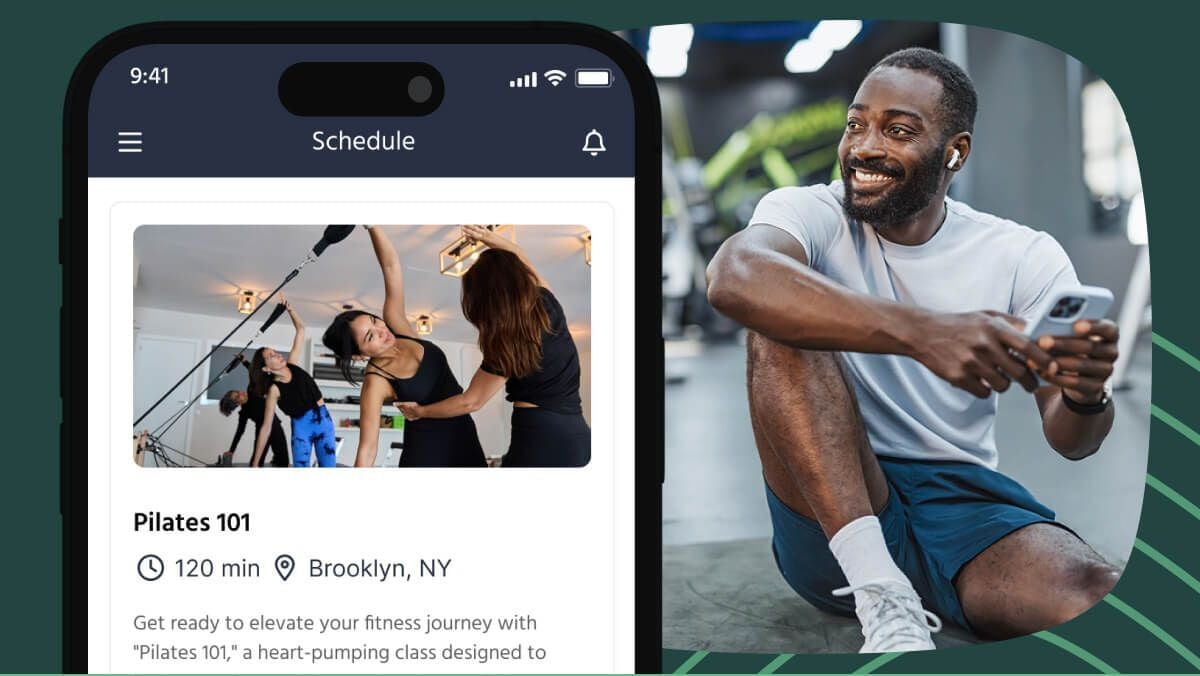It’s not uncommon for gyms to have high attrition rates. The main cause is a rapid turnover of beginners and clients without clear objectives - these clients tend to churn just a month or two after joining the gym.
However, seasoned athletes, who’ve attended a fitness program more than 12 times a month, have been reported to quit or move to a different gym far less than beginners. With less than 4 days of attendance after 3 and 6 months, beginner gym goers are much more susceptible to withdrawing their memberships.
Sooner or later, you’re bound to face similar issues with your members when operating your gym. Being pragmatic about your membership retention strategies can help you scale your business without sacrificing your long-time clients.
Find the perfect pricing
model for your fitness business
DOWNLOAD NOW 
1. Finding the sweet spot fitness-wise

Every gym is different from the others. While retaining 100% of your members for the first few months to make them regulars is impossible, you can try to find your sweet spot. Harvest data from your existing gym clients and use it to understand the:
-
Percentage of clients leaving after a month
-
The number of days they’re attending the programs each month
-
The number of months after which the attrition rate starts dropping
Depending on your gym category and programs, it may vary. Typically, 3 to 6 months is the time it takes for new starters to take their training more seriously. Design your gym membership packages based on the data. Consider giving discounts on long-term memberships to retain more gym clients.
2. Finding the sweet spot price-wise
Hooking a gym client takes more than getting them to commit to long-term memberships. If their budget and your price point don’t sit parallel, they may switch to your competitors after a few months.
Obtaining gym members is the easy part. It’s often an impulse decision taken as a new year's resolution or a health issue. The first membership investment doesn’t make a huge dent in their pockets, but monthly subscriptions do—especially when they don’t attend the gym regularly.
To keep them in the cycle, you must consider giving them yearly discounts and other economic benefits. They should never be allowed to regret their commitment to your services. Either fulfill their requirements through services or a more competitive price point. However, competing on the subscription charges isn’t always a great idea. There will always be someone offering similar services at a lower price.
Moreover, try bundling personal trainer (PT) costs with a gym membership.
3. Make new clients feel welcome in your community
It doesn’t hurt to hand-hold new beginner clients and introduce them to every trainer and coach. This particular practice gives them a sense of belonging to your gym. Additionally, you should structure on-ramps for giving your clients information about their bodies, screening, and safety measures.
As most of your gym clients would probably be beginners with weight loss or gain issues, develop a welcoming environment around your gym. Embrace a no-tolerance policy towards body shaming, equipment handling, and hygiene to empower beginners with safety and comfort.

Introducing new members to others may seem like a small gesture, but once you get them to the 6-month mark, they’re more likely to stay. They make friends easier and interact better with other individuals in the gym. The FOMO on these interactions will prevent them from switching to your competitors.
4. Consider old-timers valuable resources
Most failing gyms bring their demise by neglecting long-term clients. They often consider these members a continuous revenue source that doesn’t need nurturing. You shouldn’t think like that if you wish to retain your clients.
These gym members are your greatest source of leads through word of mouth. Most of them are considered accomplished individuals by the beginner communities and often try to follow their tracks when it comes to fitness—including their choice of gym and membership.
But how do you treat them better? Offer discounts on premium services and invite them to exclusive events and seminars as specialist voices. You might also celebrate their accomplishments publicly through social media and dedicated online events.
5. Consider avoiding part-time gym memberships
Members who are on a 3 days-or-less a week plan are considered part-time members. They usually fail to come beyond 2 days, so they don't develop a sense of belonging to the community quickly enough.
You may get them through the door fast enough, but you won’t be able to keep them for long—increasing your operation costs and failing to retain customers.
6. Provide new members with roadmaps
Quality of services, above all, ultimately determines the retention rate of gym members. Providing new members with a roadmap often plays a big part in retention. Whenever a new member purchases your gym membership, offer them long-term personalized roadmaps depending on their personal goal and ability.
You may have to hire professional dietitians and trainers for the same on a contract or incentive basis. Still, these extended visions will make your new members purchase longer memberships—increasing client retention.
7. Offer additional tangential services
Except for a few specialized gyms, most traditional gyms thrive on offering paid or free add-on services to their members. In addition to your personalized weight loss, strength training, and HIIT programs, you might also include:
-
Zumba
-
Kickboxing
-
Meditation
-
Nutrition
-
Swimming
-
Running and walking tracks
-
Yoga
-
Spa and sauna in your gym
Additional services prove to be a great source of revenue and are considered a placeholder for discouraged members. A client, for example, may not fit into your fitness programs. But they may come back regularly for swimming sessions. Cater to these gym clients as much as possible to retain membership and generate word-of-mouth leads.
8. Check in with discouraged members
Regular members who’ve achieved goals in your gym are hungry for more. However, clients who have failed to notice any significant progress or may have hit a plateau are often discouraged to the point of canceling their memberships.
Check in with these members frequently and track their attendance. Follow through with their progress and understand what’s wrong. If required, recommend other services or even refer them to other gyms where they might fit in better.
Catering to such gym clients often presents great value. In the best cases, they start to see a fair amount of progress simply after encouragement and strive to become lifelong members.
9. Opt-in for email newsletters
Enthusiasts, particularly in the fitness industry, love hearing about success stories. Email newsletters with this type of content and guidance for beginners on how to achieve such milestones will increase your client retention percentage.
If done right, personalized email newsletters can evoke a sense of belonging. Your client will look forward to it every week, and it will motivate them to keep coming back. You may also use email newsletters to reclaim lost clients and nurture newer leads.
In particular, progress stories and fitness routines work best for gym newsletters. But depending on your positioning on the market, you may also fall back on low-calorie recipes, keto diets, new positive research, or the health benefits of exercising.
10. Provide online fitness services
The Covid-19 pandemic has opened up opportunities for online fitness apps to thrive. Moreover, statistically, it costs roughly 9X to acquire new clients than nurture existing ones. If some of your members are failing to show up at the gym due to circumstances like pregnancy, accidents, or finances, you may be able to retain them through online engagement.
More and more clients are looking for online fitness services, so you might consider developing an app around your services. Grant your existing members free access to some features and allow them to upgrade to premium online services if need be.
11. Maintain gym hygiene and maintain equipment
A gym is a social place. No one ever expects it to be as clean as their kitchen, but maintaining a standard of cleanliness will make even the pickiest members happy. Consider developing an equipment usage policy so that members get used to spraying equipment with disinfectants and wiping off their sweat after usage.
Moreover, make sure your gym smells good and deep clean the whole area and equipment every week or two. Particularly focus on areas where cardio and HIIT training are facilitated. As these exercises often infuse sweat, they tend to be more moldy and smelly.
Keep your equipment in top condition throughout its life cycle. If your gym clients are failing to get their desired dosage of dopamine through exercises due to equipment failure, they might not have any reason to continue with the memberships.
12. Approach your appropriate target
Not every gym fits everyone. However hard you may try, there will always be clients who won’t resonate with your space and services. Whether it’s due to music your play or the types of routines you offer, many of your clients will naturally fall out of the loop sooner or later. Don’t waste your resources on them. Recommend them a better fit and move on. Allow your team to focus on members who fall into your target to increase retention rates.
For instance, if your gym specializes in mountaineering, don’t waste your expertise and time on individuals who have zero interest in climbing or even hiking.
13. Encourage members with realistic expectations
Don’t be the gym that fuels its revenue by filling the client’s head with unrealistic expectations. If a client wonders if it’s possible to lose 30 pounds in a week, politely make them understand what is reasonable and healthy. Make them think of fitness as an investment rather than a paid service.
You may lose a few members in the process, but they would have left eventually, regardless. Focus on serious members who are here to embrace a lifestyle and not to gain cheap accomplishments.
14. Personalize your interaction with the members
Get to know your members. Note whenever they mention a wedding, work stress, kids, and sleep. Leverage these data points to humanize your team’s approach to interacting with clients.

15. Go above and beyond
Limiting your expertise and counseling to strictly gym-related matters isn’t always the best approach when trying to retain gym clients.
Often your members will come with worries about staying “on track” during family dinners and bachelorette parties. Offer to review the items on the menu to give them healthier choices that they may choose from. Educate them by breaking down your thought process so that they can make good choices on their own in the future. Allow members to pause or downgrade their gym Membership
Financial crises can happen to anyone. Don’t let that stop your members from coming to your gym. Allow them to downgrade and upgrade their membership plans whenever necessary to sustain their lifestyle through the struggle. It may seem counterintuitive, but it bears fruit in the long run.
16. Encourage personal and online feedback
Don’t discourage your clients from criticizing your services. Own it and improve!
Publicly acknowledge the existence of negative aspects and always be open to feedback. Encourage the dissatisfied gym clients to give you another go after you’ve amended the issues. Moreover, encourage online feedback to promote your service to potential leads.
17. Encourage trainer feedback
Trainer reviews are just as valuable as your members’ feedback. Ask your trainers to review their designated members about how they are doing and what can be improved. Personally reach out to the individual gym clients and discuss the issues in detail.
However, it may backfire in specific cases if the client doesn’t wish to take fitness as a priority over their choice of lifestyle. Consider noting them down and trying a different approach to retain them as clients.
18. Group exercise classes
Group exercises can be beneficial if you’ve successfully presented your gym as a community. Competitions, Zumba classes, free swimming classes, and yoga can be great group activities that will strengthen the bond between your clients—increasing the retention rate.
19. Celebrate achievement stories on Social Media
With consent, share your clients’ achievement stories on your social media platforms to encourage them even more.
Develop a standardized milestone system to allow members to compete with each other, and feature winners and runners-up on your social media. Empower the winners with incentives like discounted memberships and limited access to premium services if possible.

20. Don’t oversell too much
It’s only natural for gyms to sell additional products and services to increase revenue and profit generation. However, that shouldn’t be done so frequently that it becomes nagging to the clients.
A good sales pitch is so subtle that it doesn’t feel like a sales pitch. Try understanding what a gym member might need and “advise” them to get a product or service for their specific need. Your clients shouldn’t be scared of coming to the gym because they’re being bombarded with overselling strategies.
21. Introduce new equipment and services frequently
Try to invest in equipment and services to improve your retention rate. For example, if it gets too humid in your area, try installing fresh juice bars in the lounge to keep them hydrated. Or, if your members love HIIT training, consider introducing high-intensity equipment
22. Keep your gym open as much as possible
Most beginner members don’t prioritize fitness and coming to the gym over their existing schedule. As a gym owner, it’s your responsibility to find a mutually reasonable time that fits their requirements.
Consider opening 6 days a week and at least 14-16 hours a day. Consider hiring managers to work in shifts to sustain the prolonged opening hours.
The bottom line
Retaining gym clients is a major issue gym owners and managers face. Hopefully, this article will give you some ideas on how to implement retention strategies geared toward new gym clients.
Implement these strategies in your daily gym operations to help your business scale with member loyalty and increased profits.
Frequently asked questions on ways to increase gym membership retention
What is a good gym retention rate?
60-70% is a good gym retention rate after 3 months of individual membership. However, it may vary depending on the nature of the athletes and the program.
Why do gyms face customer retention issues?
Gyms face customer retention issues for several reasons. Such as:
-
Less than adequate hygiene
-
Lack of customizable programs
-
Absence of personalization in approach and interaction
-
Overselling of products and services
-
Absence of online presence
-
Lack of transparent roadmaps and realistic expectations
Why is it important to have a social media profile for your gym?
You should have social media profiles of your gym spread out on different platforms. These profiles allow you to celebrate the achievements of members, promote new services, and interact with interested prospects. In addition, minor inconveniences may also be sorted through social media messaging.
What should your gym policies revolve around?
Develop gym policies around hygiene, equipment handling, bullying, and stalking. The objective is to promote a safe environment for each participant.
Find the perfect pricing
model for your fitness business
DOWNLOAD NOW 









